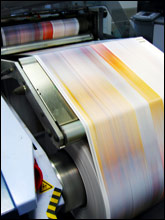
Can’t go paperless? Go green.
Photo: iStockphoto.
Look around your workplace, and you’ll likely find plenty of printed material, from business cards to brochures to books. Printing words and images on paper may seem like one of the more environmentally benign things your company does, but that isn’t necessarily the case. If you examine the life cycle of printed matter — from turning trees into paper through the witch’s brew of chemicals involved — professional printing takes on a decidedly non-green hue.
The explosion of web and digital technology doesn’t seem to have changed things — as one pundit put it, the paperless office has turned out to be about as practical as the paperless bathroom. But if you still have to print, go green.
Green printing is on a roll, moving beyond small, do-good companies and activist groups to larger corporations and government agencies that have mandates to purchase greener goods and services. As demand for green printing has grown, so too has the number of printers offering such services — or, at least, claiming to.
It’s about time. The mechanics of most types of printing haven’t changed much over the past half-century. Lithography and gravure — the methods typically used to print books, magazines, and catalogs — employ plates, which are used to apply ink to paper. Typically, the process involves a variety of inks, solvents, acids, resins, lacquers, dyes, driers, extenders, modifiers, varnishes, shellacs, and other solutions. Only a few of these ingredients end up directly on the printed page. The balance are used to produce films, printing plates, gravure cylinders, or proofs, or to clean printing plates or presses.
Many of the ingredients are toxic: silver, lead, chromium, cadmium, toluene, chloroform, methylene chloride, barium-based pigments, and acrylic copolymers. And that’s not all. Chlorine bleaching of paper is linked to cancer-causing water pollutants. Waste inks and solvents are usually considered hazardous. Bindings, adhesives, foils, and plastic bags used in printing or packaging printed material can render paper unrecyclable.
And you thought it was just ink on paper.
I Ink, Therefore I Am
Not everyone defines “green printing” the same way, and there is no standard or certification for what makes a printer — or a given project — green. For example, some printers use conventional techniques for most customers, breaking out the recycled paper and soy-based inks only when a customer asks. But others go all-out as a matter of course.

Sheet happens.
Photo: iStockphoto.
Among those in the latter category is GreenerPrinter, based in Berkeley, Calif., whose customers include Clif Bar & Co., Hewlett Packard, and the San Francisco Giants. The company uses high post-consumer recycled content, non-chlorine-bleached papers from New Leaf, one of the leading environmental paper companies. GreenerPrinter customers can receive an “environmental benefits statement” detailing the water, energy, and emissions saved for a given print job. And the climate impact of shipping finished jobs is offset through investments in renewable energy. (Full disclosure: GreenBiz.com, the nonprofit website I founded, has an affiliate relationship with GreenerPrinter.)
Then there’s Quad/Graphics, one of the nation’s largest printers, with more than 12,000 employees. For more than 30 years, Quad, based in Sussex, Wis., has been a pioneer in green-printing practices, from reducing ink and paper waste to making sure print-shop air quality far surpasses legal guidelines. The company recycles more than 98 percent of its waste and has won numerous awards for environmental leadership, though it doesn’t market itself as a “green” printer.
It’s not hard to suss out who’s green and who’s not, says Priscilla Martin, print buyer for Clif Bar. “When speaking with a new potential vendor, their views or positions on environmental considerations are generally apparent within the first few minutes,” she says. “If I’m not hearing a green message, rather than asking about it, I tell them what is important to us and see how they respond.”
And what about price? Green printing can cost a little more — but it doesn’t have to. “The major trade-off we thought we’d experience was a price increase,” says Andrea Stupka, marketing and promotions manager at Homegrown Naturals, Inc., purveyor of Annie’s Homegrown products. “But after doing a cost comparison between four printers, one of them green, we were pleasantly surprised. The slight cost increase to go green was so insignificant it was worth it.”
In fact, a green printer worth its salt will help you find ways to make projects more economical. “We spend a lot of time educating customers to show them that green printing isn’t just more environmentally responsible, it’s often better quality and more affordable,” says Josh Maddox, sales manager at GreenerPrinter. “By taking the time to show them the least wasteful way to design and produce [projects], we often save clients money over conventional printing costs. We win a lot of business that way.”
Image Consciousness
So how do you make your printing greener? Since there’s no official standard, you’re on your own to determine who’s really committed. In general, an environmentally minded printer should: use the most eco-friendly papers available; reduce or eliminate toxic chemicals, waste ink, and solvents; be willing to use soy or other vegetable inks without any price premium; educate customers about how to reduce a project’s environmental impact; and provide safe working conditions for employees, including using the most advanced air-filtration systems.
Here are three questions to ask when scoping out your particular job:
1. Can the job be printed on paper containing a high percentage of post-consumer recycled fiber?
The answer will help determine whether the printer has practical knowledge about the characteristics and advantages of different types of recycled paper. Don’t just accept “sure, we can use recycled” as an answer. Specify paper with at least 50 percent post-consumer content.
2. Can it be printed with low-polluting inks?
In most jobs, soy- or vegetable-based inks work just fine (90 percent of daily newspapers use them routinely for color printing). Avoid inks containing heavy metals like lead, cadmium, and mercury, which are commonly used to produce some bright colors. Printers should be willing to swear off heavy-metal inks and suggest alternatives.
3. What is being done to improve the recyclability of the print job?
Coatings, laminates, inks, foils, adhesives, labels, and paper selection can all affect the recyclability of a printed document. A printer should be able to find alternative ways to get the desired effect — through innovative paper sizes and newer glues that won’t inhibit recycling, for example.
As with so many things green, the more you know, the better decisions you can make. In the end, the best option may be not to print at all. “It is always good to question, ‘How important is this item to print?'” says Bryan Mazzarello, art director at Organic Bouquet. “Many times companies can offer the same information online and update it cheaper and faster. Maybe a postcard invitation to the website would be more effective than a brochure that will end up in the trash.”
As Mazzarello makes clear, green printing isn’t your only option. The greenest document of all is the one you never commit to paper.
Press Here
Good resources for green printing include: GreenBiz Green Printing Resource Center, the Bay Area Green Business Program’s Top 10 Green Printing Practices, Dynamic Graphics’ Printing Green: 12 Things You Need to Know, and Environmental Considerations for the Print Buyer from the Minnesota Environmental Initiative.



